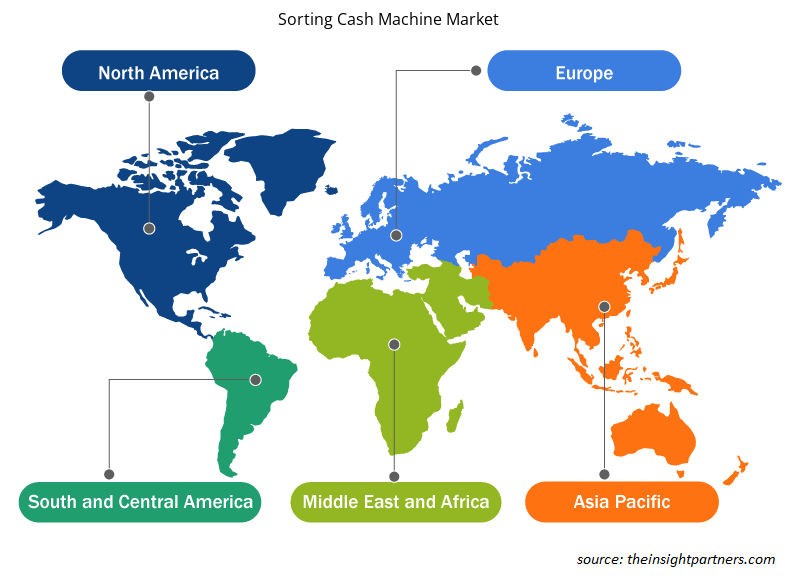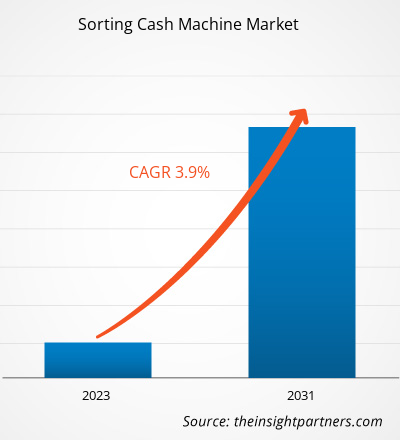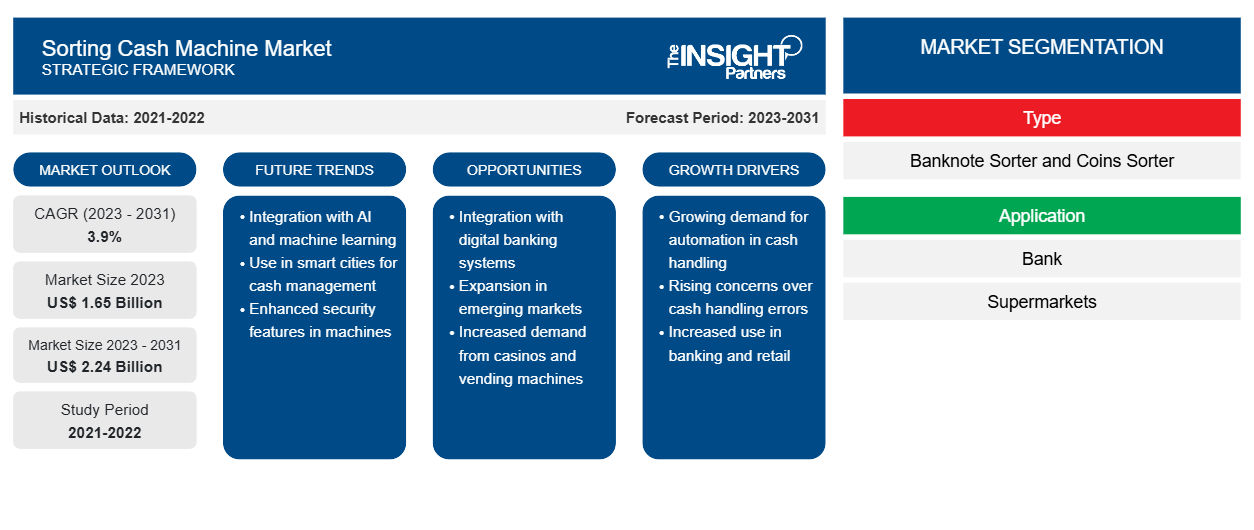Le marché des distributeurs automatiques de billets devrait passer de 1,65 milliard USD en 2023 à 2,24 milliards USD en 2031 ; il devrait croître à un TCAC de 3,9 % entre 2023 et 2031. Les développements technologiques des produits et le potentiel de marché inexploité dans les économies émergentes devraient améliorer le marché des distributeurs automatiques de billets dans un avenir proche. L'utilisation de cette machine présente d'autres avantages comportementaux, tels que moins d'erreurs de tri et de comptage, des dépenses opérationnelles moins élevées, moins de pertes financières et moins de dangers internes associés au comptage et au tri.
Analyse du marché des distributeurs automatiques de billets
Les distributeurs automatiques de billets sont utilisés dans de nombreuses entreprises et organisations financières à forte intensité de trésorerie, notamment les établissements de vente au détail, les casinos, les banques commerciales, etc. Certaines avancées en matière de machines de tri d'espèces, telles que le tri d'espèces basé sur le poids, rendent le déploiement avancé plus réalisable. Le marché est propulsé par le flux incontrôlé et non intermittent de devises dans les banques, les casinos et autres institutions financières. La circulation régulière d'espèces en vrac d'un secteur à un autre est l'une des principales causes de la demande de dispositifs de tri d'espèces.
Aperçu du marché des distributeurs automatiques de billets
- Les devises, comme les pièces et les billets de banque, peuvent être triées à l'aide d'un distributeur automatique de billets. L'appareil passe au travers d'une pile de pièces ou de billets et les trie en fonction de leurs différentes valeurs. De plus, l'argent est compté et divisé en d'autres catégories en fonction de quantités prédéterminées. Grâce à certaines mesures de sécurité, certains distributeurs automatiques de billets très développés peuvent également aider à identifier les pièces ou les billets contrefaits . Étant donné qu'une grande quantité d'argent liquide est constamment collectée, les distributeurs automatiques de billets sont utilisés dans les banques, les casinos, les institutions financières, les hôpitaux, les supermarchés et les grands parcs d'attractions.
- Les distributeurs automatiques de billets réduisent la quantité de travail nécessaire pour trier les billets et permettent de gagner un temps considérable qui serait autrement consacré au tri et au comptage des devises. Cela réduit également le risque d'erreurs qui se produisent lorsque les billets sont triés et comptés manuellement. Cela se traduit également par moins de pertes financières et des coûts d'exploitation inférieurs. Lorsqu'une liasse de billets est introduite, les distributeurs automatiques de billets commencent instantanément le processus de tri et de comptage des devises, produisant des résultats précis. La détection des billets et des pièces contrefaits contribue à protéger la réputation de l'organisation. Il reconnaît également les billets défectueux et commence à émettre un bip lorsqu'il trouve de tels billets ou pièces.
Personnalisez ce rapport en fonction de vos besoins
Vous bénéficierez d'une personnalisation gratuite de n'importe quel rapport, y compris de certaines parties de ce rapport, d'une analyse au niveau des pays, d'un pack de données Excel, ainsi que de superbes offres et réductions pour les start-ups et les universités.
-
Obtenez les principales tendances clés du marché de ce rapport.Cet échantillon GRATUIT comprendra une analyse de données, allant des tendances du marché aux estimations et prévisions.
Moteurs et opportunités du marché des distributeurs automatiques de billets
Les progrès technologiques dans les machines de tri d'argent liquide vont stimuler le marché des machines de tri d'argent liquide
- Les progrès technologiques contribuent à la croissance du marché des distributeurs automatiques de billets. Le secteur des distributeurs automatiques de billets est stimulé par de nombreux développements dans le domaine des distributeurs automatiques de billets, tels que le tri d'espèces basé sur le poids, qui permet une meilleure utilisation des espèces.
- Les machines modernes privilégient l'efficacité, ce qui permet de gagner du temps et d'augmenter l'efficacité opérationnelle d'une entreprise. Le gouvernement européen réglemente l'utilisation des machines de tri de pièces en vertu du règlement (UE) n° 1210/2010 afin de prévenir la contrefaçon de monnaie et de valider les activités de comptage et de tri d'espèces. Pour être autorisés à distribuer des appareils de tri d'espèces sur le marché européen, les producteurs doivent satisfaire aux exigences d'acceptation décrites dans les lignes directrices de la Commission.
Sensibiliser davantage à la contrefaçon d'argent liquide pour créer des opportunités de marché lucratives
- Les acteurs du marché développent des machines de tri de billets dotées de mesures de sécurité suffisantes pour éviter la contrefaçon de billets, en utilisant des technologies de nouvelle génération. Les fabricants s'efforcent de consolider leur position sur le marché en équipant ces appareils d'algorithmes fiables et de technologies de détection de billets.
- Bien que la sécurité, la précision et l'efficacité restent les caractéristiques les plus importantes des machines de tri d'espèces, les fabricants intègrent de plus en plus des écrans tactiles programmables, des graphiques de machine et une manipulation d'espèces mains libres.
- Pour obtenir un avantage concurrentiel, les fabricants et les distributeurs utilisent une technologie de pointe pour inclure des mesures de sécurité uniques et de haute qualité dans les machines de tri d'argent liquide. Le marché des machines de tri d'argent liquide devrait croître à un rythme modéré au cours de la période projetée, en raison de diverses caractéristiques du marché, notamment la diminution de l'utilisation d'argent liquide.
Analyse de segmentation du rapport sur le marché des distributeurs automatiques de billets
Le segment clé qui a contribué à la dérivation de l’analyse du marché des distributeurs automatiques de billets de tri est le type.
- Sur la base du type, le marché est segmenté en trieur de billets et trieur de pièces. La catégorie des distributeurs automatiques de billets de banque détient la plus grande part de marché en raison de sa capacité à améliorer la gestion de trésorerie en triant et en emballant correctement les billets, ce qui conduit à une productivité, une efficacité et une sécurité accrues.
- En fonction de l'application, le marché est divisé en trois segments : les banques, les supermarchés et autres. Le segment bancaire devrait connaître le développement le plus rapide en raison de l'adoption généralisée des paiements numériques, de la présence croissante des institutions financières et des banques et des avancées technologiques dans les machines de tri bancaire.
Analyse des parts de marché des distributeurs automatiques de billets par zone géographique
- Le marché des distributeurs automatiques de billets est principalement divisé en cinq régions : Amérique du Nord, Europe, Asie-Pacifique, Moyen-Orient et Afrique et Amérique du Sud. La région Asie-Pacifique devrait connaître le TCAC le plus rapide au cours de la période de prévision.
- L'utilisation croissante de l'automatisation des espèces, stimulée par l'avènement des paiements numériques, soutient la croissance du marché des machines de tri d'espèces dans la région Asie-Pacifique, alors que les entreprises et les institutions financières cherchent à accroître l'efficacité et la précision des transactions en espèces à volume élevé en utilisant ces machines.
En outre, le marché devrait connaître une expansion en raison de l’augmentation du revenu disponible, des développements technologiques dans les machines de tri d’espèces, de la demande accrue de machines de tri d’espèces dans les institutions financières et de la demande croissante de diverses industries d’utilisation finale.
Aperçu régional du marché des distributeurs automatiques de billets
Les tendances et facteurs régionaux influençant le marché des distributeurs automatiques de billets tout au long de la période de prévision ont été expliqués en détail par les analystes d’Insight Partners. Cette section traite également des segments et de la géographie du marché des distributeurs automatiques de billets en Amérique du Nord, en Europe, en Asie-Pacifique, au Moyen-Orient et en Afrique, ainsi qu’en Amérique du Sud et en Amérique centrale.

- Obtenez les données régionales spécifiques au marché des distributeurs automatiques de billets
Portée du rapport sur le marché des distributeurs automatiques de billets
| Attribut de rapport | Détails |
|---|---|
| Taille du marché en 2023 | 1,65 milliard de dollars américains |
| Taille du marché d'ici 2031 | 2,24 milliards de dollars américains |
| Taux de croissance annuel composé mondial (2023-2031) | 3,9% |
| Données historiques | 2021-2022 |
| Période de prévision | 2023-2031 |
| Segments couverts |
Par type
|
| Régions et pays couverts |
Amérique du Nord
|
| Leaders du marché et profils d'entreprises clés |
|
Tri de la densité des acteurs du marché des distributeurs automatiques de billets : comprendre son impact sur la dynamique des entreprises
Le marché des distributeurs automatiques de billets connaît une croissance rapide, tirée par la demande croissante des utilisateurs finaux en raison de facteurs tels que l'évolution des préférences des consommateurs, les avancées technologiques et une plus grande sensibilisation aux avantages du produit. À mesure que la demande augmente, les entreprises élargissent leurs offres, innovent pour répondre aux besoins des consommateurs et capitalisent sur les tendances émergentes, ce qui alimente davantage la croissance du marché.
La densité des acteurs du marché fait référence à la répartition des entreprises ou des sociétés opérant sur un marché ou un secteur particulier. Elle indique le nombre de concurrents (acteurs du marché) présents sur un marché donné par rapport à sa taille ou à sa valeur marchande totale.
Les principales entreprises opérant sur le marché des distributeurs automatiques de billets sont :
- Bcash, société d'électronique
- Cummins Allison
- De La Rue plc
- Giesecke+Devrient GmbH
- Glory Global Solutions (International) Limited
Avis de non-responsabilité : les sociétés répertoriées ci-dessus ne sont pas classées dans un ordre particulier.

- Obtenez un aperçu des principaux acteurs du marché des distributeurs automatiques de billets
Actualités et développements récents du marché des distributeurs automatiques de billets
Les entreprises adoptent des stratégies organiques et inorganiques telles que les fusions et acquisitions sur le marché des distributeurs automatiques de billets. Certains des développements clés récents du marché sont énumérés ci-dessous :
- En 2022, la Reserve Bank of India (RBI) a demandé aux banques de tester chaque trimestre la cohérence et la précision de leurs machines de tri de billets afin de garantir que les billets de banque sont conformes aux paramètres prescrits. [Source : Communiqué de presse]
Rapport sur le marché des distributeurs automatiques de billets et livrables
Les prévisions du marché des distributeurs automatiques de billets sont estimées sur la base de diverses conclusions de recherche secondaires et primaires, telles que les publications clés des entreprises, les données des associations et les bases de données. Le rapport de marché « Taille et prévisions du marché des distributeurs automatiques de billets (2021-2031) » fournit une analyse détaillée du marché couvrant les domaines ci-dessous-
- Taille et prévisions du marché aux niveaux mondial, régional et national pour tous les segments de marché clés couverts par le périmètre.
- Dynamique du marché telle que les moteurs, les contraintes et les opportunités clés.
- Principales tendances futures.
- Analyse PEST et SWOT détaillée
- Analyse du marché mondial et régional couvrant les principales tendances du marché, les principaux acteurs, les réglementations et les développements récents du marché.
- Analyse du paysage industriel et de la concurrence couvrant la concentration du marché, l'analyse de la carte thermique, les principaux acteurs et les développements récents.
- Profils d'entreprise détaillés.
- Analyse historique (2 ans), année de base, prévision (7 ans) avec TCAC
- Analyse PEST et SWOT
- Taille du marché Valeur / Volume - Mondial, Régional, Pays
- Industrie et paysage concurrentiel
- Ensemble de données Excel
Rapports récents
Rapports connexes
Témoignages
Raison d'acheter
- Prise de décision éclairée
- Compréhension de la dynamique du marché
- Analyse concurrentielle
- Connaissances clients
- Prévisions de marché
- Atténuation des risques
- Planification stratégique
- Justification des investissements
- Identification des marchés émergents
- Amélioration des stratégies marketing
- Amélioration de l'efficacité opérationnelle
- Alignement sur les tendances réglementaires























 Obtenez un échantillon gratuit pour - Marché des distributeurs automatiques de billets
Obtenez un échantillon gratuit pour - Marché des distributeurs automatiques de billets